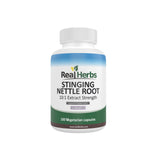Stinging Nettle Root in Ayurveda: Healing Properties Unveiled
Introduction
In the realm of holistic health and traditional medicine, Ayurveda stands as a time-tested system with roots dating back thousands of years. Central to Ayurvedic practices is the use of medicinal herbs, each revered for its unique healing properties. One such herb that has captured the attention of Ayurvedic enthusiasts is the Stinging Nettle Root. Despite its infamous stinging quality in the wild, this humble plant holds a special place in Ayurveda, celebrated for its potential therapeutic benefits.
Historical Context
To understand the significance of Stinging Nettle Root in Ayurveda, it's essential to delve into the historical tapestry of both Ayurvedic medicine and the utilization of this intriguing herb. Ayurveda, originating from ancient India, encompasses a holistic approach to well-being, emphasizing the balance of mind, body, and spirit. Stinging Nettle Root, scientifically known as Urtica dioica, has been woven into this holistic framework, becoming a staple in traditional remedies and formulations.
Botanical Overview
Urtica dioica, commonly known as Stinging Nettle, is a perennial plant that thrives in temperate regions across the globe. Its serrated leaves are infamous for delivering a stinging sensation upon contact, but beneath this seemingly defensive exterior lies a root with a rich medicinal history. In Ayurveda, the root of the Stinging Nettle plant takes center stage, believed to harbor a treasure trove of healing properties.
Ayurvedic Perspective
Ayurveda views health as a delicate balance, influenced by the interplay of three doshas – Vata, Pitta, and Kapha. Stinging Nettle Root is embraced in Ayurvedic philosophy for its potential to restore this equilibrium. The herb is believed to possess qualities that align with specific doshas, making it a versatile remedy in Ayurvedic practices. As we journey into the healing realm of Stinging Nettle Root, it's crucial to explore how Ayurveda harnesses the power of this plant to promote overall well-being.
Healing Properties
Stinging Nettle Root in Ayurveda is praised for its multifaceted healing properties. Among its acclaimed virtues are anti-inflammatory and antioxidant effects. Ayurvedic practitioners believe that these properties can contribute to the alleviation of various health concerns. Preliminary scientific studies suggest that compounds found in Stinging Nettle Root may indeed possess anti-inflammatory characteristics, supporting the traditional claims made by Ayurvedic practitioners.
Traditional Uses
The rich tapestry of Ayurvedic remedies intertwines with Stinging Nettle Root, showcasing its versatility in addressing various health issues. Traditionally, the root has been used to support joint health, aid in digestion, and even as a tonic for overall vitality. Ayurvedic formulations often incorporate Stinging Nettle Root alongside other herbs to create synergistic blends designed to target specific health imbalances. From teas to tinctures, the herb has been seamlessly integrated into Ayurvedic regimens, offering a holistic approach to health maintenance.
Modern Research and Studies
In recent years, scientific interest in Stinging Nettle Root has surged, leading to a growing body of research exploring its potential benefits. Studies have investigated its impact on conditions such as arthritis, allergies, and prostate health. While more research is needed to fully validate these claims, the emerging evidence suggests that Stinging Nettle Root may indeed hold promise in modern medicine, aligning with the ancient wisdom of Ayurveda.
Dosage and Precautions
As with any herbal remedy, understanding the proper dosage and potential precautions is crucial. Ayurveda emphasizes an individualized approach, and consulting with a qualified practitioner is advisable. Generally, Stinging Nettle Root can be consumed in various forms, such as capsules, teas, or tinctures. However, it's essential to be mindful of potential interactions with medications and any allergic reactions. Pregnant individuals and those with specific health conditions should exercise caution and seek professional advice before incorporating Stinging Nettle Root into their wellness routines.
Conclusion
In the intricate tapestry of Ayurveda, Stinging Nettle Root emerges as a noteworthy player, offering a holistic approach to well-being. From its historical roots in traditional remedies to the spotlight of modern scientific inquiry, the herb stands as a bridge between ancient wisdom and contemporary understanding. As we unveil the healing properties of Stinging Nettle Root, it becomes clear that its journey extends beyond folklore – it intertwines with the evolving narrative of holistic health.
In Ayurveda, where balance is the key to vitality, Stinging Nettle Root finds its place as a potential ally. Whether used to address specific health concerns or integrated into daily wellness routines, the herb invites exploration under the guidance of qualified practitioners. As we navigate the realms of tradition and science, the story of Stinging Nettle Root unfolds as a testament to the enduring synergy between ancient knowledge and modern inquiry.
References
- Chopra, R. N., Nayar, S. L., & Chopra, I. C. (1956). Glossary of Indian Medicinal Plants. Council of Scientific and Industrial Research, New Delhi.
- Roschek, B., Fink, R. C., McMichael, M., Alberte, R. S. (2009). Nettle extract (Urtica dioica) affects key receptors and enzymes associated with allergic rhinitis. Phytotherapy Research, 23(7), 920-926.
- Mittman, P. (1990). Randomized, Double-Blind Study of Freeze-Dried Urtica dioica in the Treatment of Allergic Rhinitis. Planta Medica, 56(01), 44-47.












